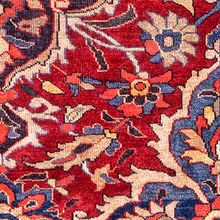Ferdos Rug
| Ferdos Rug | |
|---|---|
 Design of Ferdos Rug (Rugman) | |
| General information | |
| Name | Ferdos Rug |
| Original name | قالی فردوس |
| Alternative name(s) | Ferdos Carpet |
| Origin | |
| Category | Village |
| Technical information | |
| Common designs | Geometric, Tree |
| Common colors | Red, Begie, Blue |
| Dyeing method | Natural, Synthetic |
| Pile material | Wool |
| Foundation material | Cotton |
| Knot type | Asymmetrical (Persian) |
Ferdos rugs originate from Ferdos, a small town in the Province of Khorassan in northeastern Iran. Rug weaving in Khorasan goes back thousands of years. Known for their beautiful hand made traditional rugs, Ferdos was also the birthplace of Ferdowsi, one of Iran's greatest poets and scholars. Ferdos boasts the first tribal members to weave traditional rugs for personal use as well as for trade. Even today, the Ferdos villagers produce the finest quality traditional rugs with the same marvelous technique that they’ve been using for centuries. Jufti knots are seen in traditional rugs from this region. They are like the Persian knot with depressed warps but the knot loops around two warps at a time rather than one.
History
Ferdos, also spelled Ferdows, is a town located in the Khorasan Province of eastern Iran and is mostly populated by Arab Baluch tribes. In the antique market older Ferdos rugs are known as Arab Boft, which means, “woven by Arab Baluch tribe members.”
Before World War II Ferdos formats ranged from tribal items to PRAYER RUGS. After the war many of the Ferdos weavers began to make a new style of rugs and carpets sizes were extended to room dimensions. This nomadic style with simple coloration became successful and was in demand in Western markets.
Meshad dealers for Western clients commissioned some of these room-size carpets. Generally, Ferdos woven rugs are low in grade quality and they were lower in price compared to all other Baluch tribal rugs woven in KHORASAN.[1]
Materials
Foundation and Pile
Ferdos rugs have a wool foundation and a wool pile; afterWorld War II the foundations were mostly made with cotton.[2]
Techniques and structures
Color and dyeing
older weavings usually contain red or dark blue colorations for the background. In addition to these colors, ivory, orange, blue, gray, and brown are included for the design motifs and borders. After the war many of the Ferdos weavers began to make a new style of rugs and carpets with natural sheep wool colors of white, brown, and black.[3]
Motifs and Designs
The medallion, palmette, and Minakhani (rosette-linked trellis) designs were especially popular in the older weavings. After the war rugs have a simple allover or medallion design, or, at times, an Open Field style.[4]
Weaving techniques
The Persian (asymmetric) knot is the weaving technique employed.[5]
See also
References
Bibliography
Abraham Levi Moheban, (2015), The Encyclopedia of Antique Carpets: Twenty-Five Centuries of Weaving, NewYork: Princeton Architectural Press.